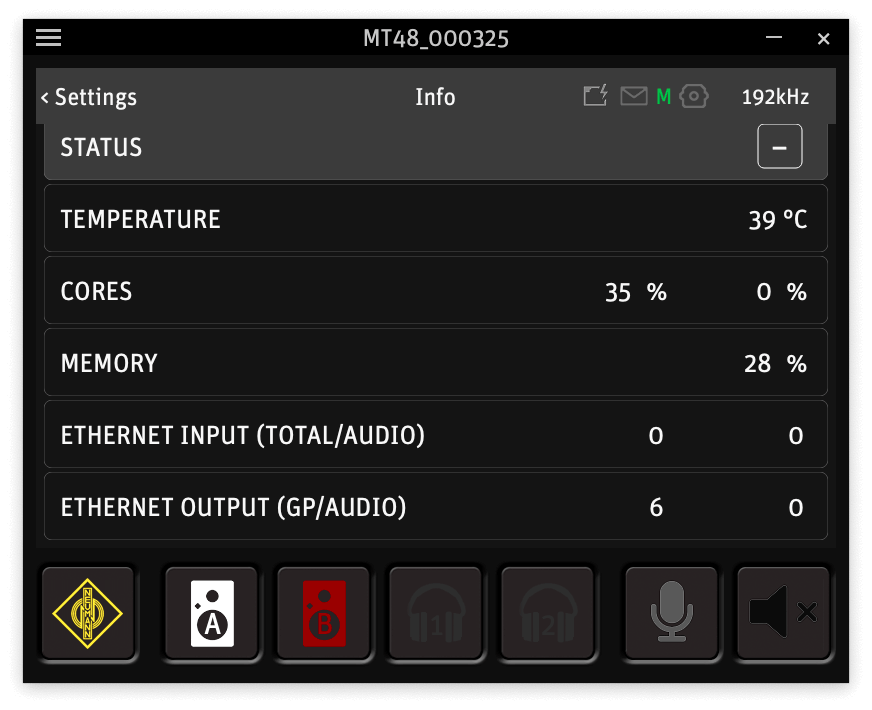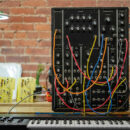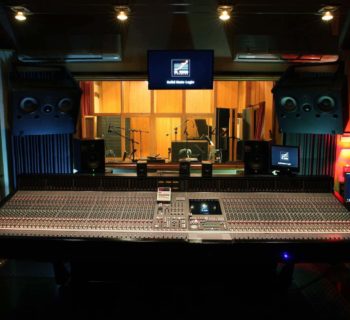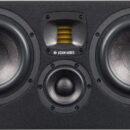Neumman has acquired Merging, and the move has been celebrated by the professional world. Merging has been in the High End converter circle for years and with its small Anubis, in size alone, has redefined the level of quality in desktop audio interfaces.
October 2023
Neumann MT 48 is identical in hardware to Merging Anubis. The differences lie in the ability to connect the MT 48 via USB C while retaining the Ethernet connection for Audio Over IP via AES67/Ravenna, the addition of eight-channel optical ADAT I/O ports that can also be converted to S/PDIF, the power supply provided by a power supply that is also USB C (in contrast, Anubis has a dedicated external power supply), and most importantly the operating environment that on the MT 48 was born for the recording and production studio. Anubis owners know a couple of interesting things: aside from the excellent quality of conversion and preamplification, Anubis can count on different Missions, that is, the ability to load different operating environments according to purpose. It started with Mission Monitor and recently came to Music, dedicated to recording and mixing, thanks also to the effects of dynamics, equalization and reverb. The MT 48 Music operating environment is an adaptation of Anubis Music with some auxiliary functions but currently without reverb. Those who use Anubis have had the less than exhilarating experience of configuration and installation on the Ethernet network, which required several steps and a knowledge of the Ethernet protocol. Problems arose from background applications or operating system obstacles. Solvable, when present, but not within the reach of a sound engineer.
We are at the beginning of an important story for Neumann: MT 48 is destined to have new operating environments, internal third-party plug-ins that perhaps can also be applied to DAW, full integration with Neumann monitors equipped with an AES 67 port (currently MT 48 can only be used via USB and there are no AES67 drivers that will be implemented in the future, however, it is possible to use MT Discovery for programming), Dolby and multichannel monitoring (currently only stereo), full integration of Neumann MA-1 for listening alignment, losing the current integration on Anubis with Sonarworks Sound ID. A License page clearly indicates that there will be a future of third-party plug-ins as is happening with Merging Anubis.
We already hear someone wondering if MT 48 can be connected to the iPad: the answer is yes, because MT 48 is Class Compliant on Mac (it requires drivers on Windows instead) but does not draw power from the USB-C bus. At most, Neumann informs us, one can briefly opt for a USB power bank or use PoE+ power using the Ethernet port.
Programming
MT 48 uses the same scheme as Anubis, derived from the broadcast environment. There is no control panel on the computer, as on other audio interfaces, except for those for setting the sample rate and buffer. All programming is done by calling up on the Internet address assigned, either automatically or manually, to the interface. Just open the IP address and you are done. There is a third option that we will see, included in Toolkit to download from the Neumann website. When using the Ethernet port, as on Anubis, it will be possible not only to access directly from the computer but also from any other device connected on the same network with a browser. One will then be able to use a tablet to control MT 48 negating the need to go through the display. Very convenient and above all modern, considering also how professional studio audio is evolving. DANTE which is compatible with MT 48 through the AES 67 protocol.
There are no parameters that are not reachable from the browser and, as on the display, the metering works in real time. The browser page exactly mimics the display, with more ease in programming because the size of a 27-inch display is quite different from the touch screen display of MT 48. Obviously.
The USB driver
MT 48 currently uses Thesycon's ASIO 2.3.1-compatible driver and is integrated with Windows as a WDM/DirectX standard, also including the MIDI interface, with support for 64-bit applications. From the very simple control panel, sample rates up to 192 kHz can be selected. Presonus Studio 6 also informs us of latency values: at 192 kHz 3and 64-sample buffer we are at 1.44 ms input latency and 3.31 ms output latency. At 48 kHz and 64 samples we are at 2.75 ms input and 4.25 ms output. With low Dropout protection (128 samples), low-latency monitoring has a roundtrip of 8.33 ms, which for Instrument drops to 5.58 ms. Under Standard conditions, the roundtrip is 13.7 ms and per Instrument 9.59 ms, again with 128 samples.
On the other hand, hooking up with the Mac is much easier than with Windows, because MT 48 is Class Compliant. There is also no need to install the Toolkit to reach the programming page on Google Chrome. In this regard, the trick for both operating systems is simple, following these steps:
1 Press and hold the first button on the left for a few seconds, which is used to bring up Settings and also functions as Return.
2 Select Settings
3 Select General
4 Scroll down to Network: here you can find the IP address assigned to MT 48, which can also be chosen manually or left with the Auto option.
5 Open Google Chrome and enter the address. Google will tell you that the site is not secure but continue and the MT48 page will open from which you can access all the programming parameters as displayed on MT 48.
6 Press the first button on the left again to return to the mixer page of MT 48
Inputs and Outputs
MT 48 can handle up to 48 inputs in the mix, which includes the four analog, the eight ADAT and the 36 AES67 channels. With the built-in ZMAN AES67 module, MT 48 can access 64 Ravenna/AES67 streams and up to 256 channels, which are programmed from MT Discovery by accessing the ZMAN folder. AES 67 stream programming for Neumann monitors is also accessed from MT Discovery.
Input enablement can be programmed directly on the interface, where you can enable physical input groups, divided into four analog inputs, eight ADAT inputs, four analog Post Fx inputs, eight digital ADAT Post FX inputs, built-in microphone, and up to eight channels of Bus Return Mix1, Mix2, Mix3, and Mix 4. The maximum number always remains 48, but Peer channels resulting from Audio Over IP connection via Ethernet can also be included in a more complex routing. Up to four independent stereo pairs of playback from the DAW can be defined. The total outputs are 16 and include the two main balanced outputs, the two Line Out 3-4 outputs, the two stereo headphone pairs, and the eight ADAT channels. Interestingly, MT 48 automatically assigns the channel number that will see the DAW according to the amount of physical inputs activated. The assignment is not fixed but dynamic, so it pays to set the inputs permanently and never think about it again, or else go to see which channel an input has been assigned to.
The effects
There are currently three: a four-band equalizer, a dynamics processor with compressor, gate and limiter, and a global reverb. The implementation of MT 48 is powerful. Each individual channel of the mixer can have dynamics and eq, with the possibility of also using them on the four mix bus, called up by pressing the Mix button . The equalizer is at the moment always before the compressor and offers four fully programmable bands, each of which can take on the role of High Cut, Low Cut, Peak, High Shelf and Low Shelf, with no range limit and with Q that can be as high as 100.
The dynamics module allows the signal from the DAW or other mixer channels to be used as a sidechain, as long as the compressor is also inserted on the channels that will sa sidechain, and has gate, compressor and limiter functions, which can be activated independently of each other. The compressor has all the parameters you would expect to have, including an autogain and the ability to work in mono. It is not currently possible to change the position of the compressor relative to the eq before it, nor is it possible to use the equalizer to process the sidechain.
Different is the case with reverb: the send can be activated on all channels from Menu>Show Effects Knobs. Programming is done by pressing on the Rev name of the dedicated mixer channel, which is also an effect return. The parameters are very simple.
Music Mission under pressure
Let's come to the conversion quality: in a word, excellent. We are in the same territory as Anubis, the interfaces being identical but with different power supply: the quality is unattainable for other desktop interfaces of similar size and price. Transparent, dynamic, highly accurate in both A/D and D/A conversion, it has the immense advantage of never being able to send the audio input A/D converter into digital distortion. The flexibility of the input converters makes it possible to abandon the soft clips seen on other converters. This is no small advantage, not least because MT 48 is always very quiet.
In listening, MT 48 knocks out a lot of recent pieces where you pick up imperfections related to microphone or preamp distortion or excessive processing on harmonics. It feels like putting a lens on the mix and recording quality. And the great thing is that you don't have to have seven-figure monitors to hear these flaws: even on monitors well under 2,000 euros you can hear the problem just fine, if there is one. If, on the other hand, the track has been mixed and recorded very well, MT 48 describes microdynamics, short delays, transients, and environments with great detail that add to the excitement of listening.
Here is an example of a clean track recorded directly from the mono output of Cyclone Analogic Beat Bot at 44.1 kHz 24 bit:
By increasing the input gain to the maximum, with absurd values, MT 48 becomes a sound design tool because you can hear all the harmonic distortion of the preamp, but not that of the converter! For example, for electronic music there are distorted results on the speakers and snare drum, using the preamp badly, that are still musical and useful. That's what happens to overdo the preamp and clip the channel, putting in eq, compressor and reverb as standard on the MT 48 mixer:
Said in another, more professional way, one can forget to precisely control the level of the preamp, because even in cases of peaks the digital distortion does not take over, or at least it is not really appreciated with the ears, but only the analog distortion of the preamp. The smallest price to pay for making the preamps work a lot is the activation of the internal fan, but it appears only for a few moments and does not disturb much. In the mix phase, the fan never showed up at the window-Neumann says it was only put in for safety.
Both the compressor and the eq belong to the category of transparent plug-ins, without a sound of their own but with the virtue that once applied they maintain exactly the original sound without ever making it artificial. Once activated and programmed, they become part of the original sound and do not seem to be present at all. Nothing like other equalizers and compressors found on audio interfaces. If they were separate plug-ins, they would probably be appreciated in mastering for their transparency quality. However, they also have an aspect for sound design that is unexpected: the eq, with Qs above 30, becomes a fantastic tool for pinpointing individual instruments or harmonics, twisting the distribution of sounds. Nothing that cannot be done with another eq plug-in on the DAW, but at these limits we did not expect such a musical sound, and again, the eq is unobtrusive. The dynamics processor is equally powerful, but still respectful of the original signal. Both allow you to get to the result in the mix with little effort. Since eq and compressor are available for every single channel of the mixer, including returns from DAW, ADAT channels, and streams, it is clear how powerful MT 48 is! The management of 18 snapshots, independent for eq, dynamics and reverb, makes it possible to be very quick in assigning the same settings to multiple channels. To this must also be added the ability to save and load snapshots to disk.
The reverb is finally a proper reverb: its programming, which is invoked by pressing on Rev in the mixer, is very simple but effective. The wet/drive control is the reverb fader. Using short reverbs produces very realistic room effects that can completely change the end result, for the better. Still the previous example to which the reverb was added. If anyone is thinking of Genesis, they are not far from that sound....
The singer or musician listening to themselves on headphones will appreciate the depth and naturalness of the reverb. There is another aspect that should not be underestimated: although it is a four-band eq, there is already enough room for ambient correction of the audio monitors. It will be interesting to see how Neumann will integrate the MA 1 system on MT 48, because there is already a nice base to work from. For now we have copied the equalization curve of MA1 using approximately the four bands and with a good result.
How much does all this power cost in terms of DSP? To find out, you can go to Settings>Info and check the working percentage of the two Cores, as well as the memory used and a couple of other interesting parameters, such as temperature (the MT 48's metal chassis acts as a heatsink, so it gets hot) and Ethernet streams.
Here we come to an important point about MT 48, which remains an Audio Over IP interface, over Ravenna/AES 67 protocol, with a second USB interface bridging Mac and PC. This is why it is possible to program the interface from the browser, although more than once we have switched to working on the touch screen during programming because it is more immediate or for minor bugs that include lags in parameter selection and control, but without MT 48 ever losing the audio connection! On Mac we did not have to install anything special: MT 48 was immediately recognized and posed no problems living with the operating system and internal mixer. The toolkit is useful for loading firmware, quickly calling up the browser, accessing remote control that duplicates the touch screen on computer monitors, and will be used for licensing in the future.
An important mention for headphones: the two amplifiers are among the best ever among interfaces and do not require a second headphone preamp. Finding the right level is always super easy, thanks to the two options that actually change the input impedance.
Less well, however, is the fact that at the moment the routing only allows the stereo output of the Mix to be assigned to one of the possible outputs between Main, Line Out 3-3, HP 1, and HP 2. The four mixes are all identical, that is, they replicate inputs and outputs of Mix 1 in terms of input signals and effects applied to individual channels, including reverb. Only the bus eq and dynamics are not carried over to the other mixes, but this is easily remedied with snapshots.
The ability to record separately the original track, the same track processed with eq and compressor, and finally the same track treated with reverb is excellent: keeping the clean track will allow it to be processed later, while it is always possible to use the one already processed, as in the audio examples. There is, however, a flaw hidden between the lines: MT 48 does not take into account the latency of the DSP. At 44.1 kHz compressor and equalizer introduce six delay samples into the processed track, which becomes about eight with reverb. When the three tracks are then put into playback, the comb filter immediately appears and the tracks must be manually adjusted.

The first track above is for conversion only, the second is the track processed by compressor and eq, and the third is the reverb track. You can notice the difference samples.
It is true, however, that what you hear at the outputs of MT 48 is not the combination of the three tracks derived from a single input: at the audio outputs come the tracks related to eq+comp and reverb. Only this one is to be aligned manually if al you want to keep with clean tracks. And while we're at it, let's talk about the latency of the USB interface, for the management of which the converter's Roll Off filter must be taken into account: when recording, it's best to choose the Slow option, which introduces 9 samples for processing. To these must be added the USB computer roundtrip, which brings the latency of MT 48 to good and more than acceptable levels in recording, but far from what can be obtained from Thunderbolt. We agree wholeheartedly with the choice to use USB instead of Thunderbolt, because it makes MT 48 suitable for any computer and ensures that even many years from now it can be used profitably, as opposed to Apple's standards (see Firewire), which are in danger of disappearing from computers. The driver is most stable, but latency times on USB may be a point of improvement when compared with the competition. It cannot be ruled out that over time Neumann and Merging will put their hands on this aspect as well. As it is, MT 48 is perfectly capable of conducting a recording with buffers of only a few samples. Of note, using the Ethernet connection for Ravenna/AES 67 significantly reduces latency times compared to the USB driver.
Speaking of GUI, the considerations are identical for the touch screen and the browser, which reproduces the display with a larger area. The difference is that in the browser we can work on all the effects of a channel strip, which are interlocked, while on MT 48 we have to call them up by pressing on the channel name or the selected Mix. There are some somewhat annoying inconsistencies: for example, the peak reset is achieved by pressing Menu from the mixer page on MT 48, while in the browser it is in the top left corner. These are easily fixable choices. Occasionally the browser loses the ability to program a parameter, without disconnecting from MT 48, so we often found ourselves working on the touch screen, which is clearly visible, though not as responsive as a state-of-the-art smartphone, but does not hinder work or make it irritating. There is a third possibility that comes from installing the Toolkit: Remote Controller invokes a small window that exactly replicates the touch screen of MT 48 with the same logic of operation thanks to the virtual buttons, and it can coexist with the browser. It is much more stable than the browser because it is literally glued to MT 48. In general we work quickly on MT 48, but sometimes we get lost because we have to remember whether some parameters are reached from one menu or another on the browser. We appreciate the effort, but perhaps better can be done for navigation and glance on all channels.
The rubber buttons are the only weak point of the construction: they are very sensitive to touch but we wonder how the rubber will become after ten years of heavy use. It was better to have them rigid. We were unable to try the MIDI connection, waiting for the GPIO/MIDI cable. We have to wait to see Anubis' Mission Monitor integrated, and ultimately we are only at the beginning of a story that promises to be a winner and ready to be a game changer. Neumann meanwhile has put together a series of YouTube tutorials that can guide those starting out
Conclusions
Neumann MT 48 takes the conversion and preamplifier quality of desktop interfaces to higher levels, transparent but not sterile, with a few tricks up its sleeve, derived from the broadcast world. It is an Anubis with a suit, for now, perfect for music production, with no complications for computer connection. While it is already operational in this area, both for recording and mixing, thanks to the enormous AES67 potential, which means being able to directly connect and control Neumann monitors with this interface, manage multichannel monitoring in full autonomy, expand and integrate the system with AES67, Ravenna or Dante compatible converters. The MT 48 is a candidate to become the mainstay of a modern digital system, providing the professional conversion and preamplifier quality that is indispensable in pro studios.
The price is higher than average but is justified by the construction, quality, and work for Audio Over IP. After seeing the evolution of the MA 1 correction system and the KH 750 sub, which took many months but did not betray expectations, we can bet that MT 48 will grow a lot in the coming months, Merging's know-how being behind it. It is now a matter of best integrating Merging's past, with stellar multichannel converters, the present of Neumann monitors with digital input with sound correction, and the future of Audio Over IP in production studios. A leap forward by Neumann that points everyone to the future of music production, mixing and mastering studios, ferrying the sound engineer from USB to Ethernet connection unhindered. MT 48 is that starting point that even years from now will play a central role in the studio, without ever betraying audio quality.
Pro
- Excellent conversion
- Neutral and accurate preamplifiers
- Transparent and accurate EQ and dynamics
- USB, Ethernet and ADAT connections
- Controlled via Ethernet
- Future integration with AES67 monitors
- Rugged construction
- Two impedance values for headphones
- Trimmer on audio outputs down to -36 dB
- Ultra-low latency on AES67/Ravenna
Cons
- No de-esser
- Eq not used for sidechain
- Limited routing with USB drivers
- No trimmers on audio inputs
- Minimal monitor controller parameters on Music Mission



























